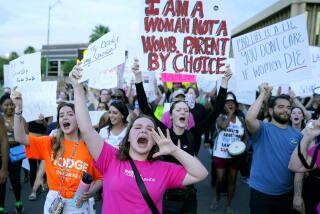Senate Defeats Compromise Abortion Bill
- Share via
WASHINGTON — The Senate on Thursday resoundingly defeated a Democratic proposal to outlaw most third-trimester abortions, clearing the way for the all-but-certain adoption of a measure that would ban a single late-term procedure widely called “partial-birth” abortion.
On a 64-36 vote, senators on both sides of the abortion issue joined forces to defeat a proposal that aimed for the narrow middle ground in the divisive debate over abortion late in pregnancy. Drafted by Senate Minority Leader Tom Daschle (D-S.D.), the measure had won the endorsement of President Clinton, who asked last year for legislation that would limit late-term abortions to women whose health or future fertility would be gravely endangered by continued pregnancy.
Clinton’s appeal came as he vetoed legislation passed by Congress that would have banned the “partial-birth” abortion procedure. The White House has indicated that the president will veto similar legislation if it reaches his desk again this year.
The Daschle amendment was one of two Democratic-backed proposals rejected by the Senate on Thursday. Earlier in the day, senators voted, 72 to 28, against a measure proposed by California Democratic Sens. Dianne Feinstein and Barbara Boxer.
It would have broadened the exemption contained in the ban on “partial-birth” abortions, which abortion providers call “intact dilation and extraction,” and allowed a doctor to proceed with the procedure in cases where a woman’s health would be threatened by continued pregnancy.
The un-amended bill, which could come to a Senate vote early next week, would allow exceptions to the ban only in cases where a pregnant woman’s life is at immediate risk.
Boxer and Feinstein joined 11 Democrats in voting against the Daschle amendment, which would have outlawed abortions conducted after a fetus has achieved “viability” and can survive outside the womb.
By contrast, the bill expected to win approval next week would affect a procedure performed late in the second trimester, before a fetus has achieved viability. While fetal viability is widely believed to begin between the 23rd and 28th week of pregnancy, the “partial-birth” abortion is used from roughly the 20th week of pregnancy.
The Supreme Court, in its landmark 1973 ruling that made abortion legal, ruled that the government may not regulate a woman’s access to abortion before the fetal viability milestone has been achieved. In crafting the amendment rejected Thursday, Daschle and others sought to impose abortion limits within those constitutional guidelines. They argued that the measure now headed for victory would be unconstitutional.
Backers of the Daschle amendment also asserted that their proposal would have halted a larger number of abortions than would the “partial-birth” abortion bill, because the amendment would outlaw all procedures conducted in the final trimester of pregnancy. Those include not only the “intact dilation and extraction” procedure, but several other grisly abortion methods--all described in detail on the Senate floor.
In the “intact dilation and extraction” procedure that would be outlawed by the bill now before the Senate, a doctor pulls all but the head of a fetus out of the birth canal and plunges scissors into the base of the skull, then suctions out the fetal brain. The procedure sparked widespread revulsion when described in a series of congressional debates and prompted many lawmakers who normally favor abortion rights to vote for the ban.
Daschle had counted on winning the support of many of those lawmakers, as well as the support of abortion foes who would be attracted by the amendment’s effect on a range of late-term abortions. And he expected to get substantial support from fence-sitters on the issue.
But he got few votes from either camp and all 13 senators with mixed records on abortion voted against his proposal.
Antiabortion activists excoriated the amendment, arguing that its health exemptions would be too lax and that its impact would be nil. And they added that it would do nothing to prevent abortions late in the second trimester.
They also ran advertisements in six states where undecided lawmakers are up for reelection or where legislation banning partial-birth abortion is pending.
Meanwhile, abortion-rights activists asserted that the Daschle amendment would cause a chilling effect on doctors helping to protect women in medical crises. And they noted that it would cause substantial mental anguish to women whose fetuses had died or were certain to die shortly after birth, but whose health was not endangered by carrying the ill-fated fetus to term.
The heated debate over late-term abortions would affect a small fraction of the roughly 1.5 million abortions performed each year in the United States. According to the Alan Guttmacher Institute, which tracks U.S. abortion data, no more than 600 abortions a year are performed on women carrying fetuses that have reached viability. More recently, the American Medical Assn. pegged the figure at 320.
Most of those are performed under laws in effect in 40 states and the District of Columbia that limit post-viability abortions to cases in which maternal health is at risk from continued pregnancy. Abortion foes have called such exemptions far too broad because they have regularly been interpreted to include such “social” considerations as depression and emotional distress.
The Daschle amendment would have narrowed that exemption, requiring a doctor to certify that a continued pregnancy would cause “grievous injury” to a woman’s physical health. But because it would have applied only to the 10 states that do not now restrict post-viability abortions, experts acknowledged its effect would be minimal.
Of those 10 states, only one--Colorado--is home to clinics that regularly perform post-viability abortions.
The “partial-birth” abortion ban potentially could affect many more abortions, since it would cover some abortions conducted in the fourth, fifth and sixth months of pregnancy. It is not known how many such procedures are performed each year, but antiabortion activists estimate that there could be tens of thousands.
More to Read
Get the L.A. Times Politics newsletter
Deeply reported insights into legislation, politics and policy from Sacramento, Washington and beyond. In your inbox twice per week.
You may occasionally receive promotional content from the Los Angeles Times.











